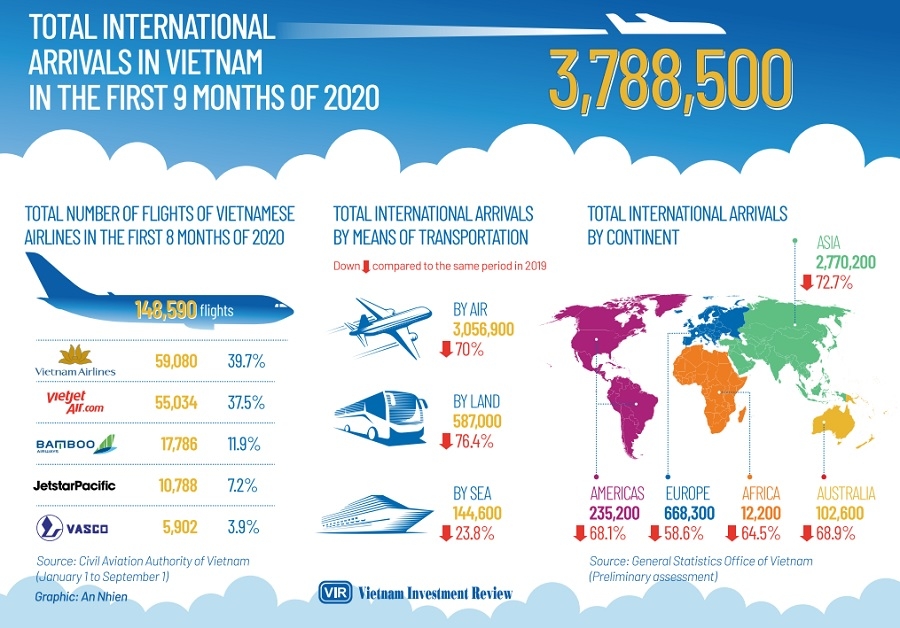Vietnamese Aviation & Tourism coming back to life
 |
| Vietnamese Aviation & Tourism coming back to life |
On September 25, over a hundred passengers from Seoul landed at Hanoi’s Noi Bai International Airport via a Vietnam Airlines flight, marking the first routine commercial inbound flight in six months. Previously, Vietnam Airlines had re-initiated regular commercial flights between Hanoi and Tokyo, and since September 30, the airline has also resumed regular flights between Ho Chi Minh City and Tokyo. Vietnam Airlines is expected to restart additional international commercial routes between Vietnam and China, Taiwan, Laos, and Cambodia.
Meanwhile, Nguyen Thanh Son, Vietjet’s deputy general director, confirmed that the airline has restarted regular flights between Ho Chi Minh City and Tokyo and Seoul as well as between Hanoi and Taipei from September 29, with a frequency of one round-trip per week. The airline also plans to resume routes with Thailand, Singapore, and some other Southeast Asian countries.
According to the plan submitted by Vietnam Airlines and Vietjet, there will be four flights to Hanoi every week on Tuesdays, Wednesdays, and Thursdays with a maximum of around 1,300 seats, and five flights to land in Ho Chi Minh City on Tuesdays, Wednesdays, Thursdays, and Fridays with a maximum of 1,290 seats.
Initially, the government has appointed Vietnam Airlines, Bamboo Airways, and Vietjet to restart some international flights. When the situation improves, Pacific Airlines will also be allowed to restore international routes.
In addition to domestic flights, Bamboo Airways will restore some of its previous overseas routes as well as open new ones. On September 29, the airline reopened the Hanoi-Taipei route. Starting from October 7, the airline will also reopen routes from Hanoi and Ho Chi Minh City to Seoul and Tokyo.
Meanwhile, the Civil Aviation Administration of Vietnam has received confirmation from Chinese aviation authorities that China Southern Airlines can operate on the Guangzhou-Ho Chi Minh City route.
Japan and Taiwan both appointed Japan Airlines and All Nippon to fly from Tokyo to Hanoi and Ho Chi Minh City; and China Airlines and Eva Air to fly from Taipei to Hanoi and Ho Chi Minh City.
From the beginning of September, airlines have also restored almost the entire domestic flight network to its status before the pandemic. Although the recovery of the domestic network and some international routes is a positive signal, Le Hong Ha, deputy general director of Vietnam Airlines and member of the Tourism Advisory Board, said that the domestic market is not the main source of income.
“A long-range international route earns 10 times more revenue than a domestic one. Therefore, international flights accounts for a large proportion in the financial structure of an airline. Additionally, these routes also represent the main revenue source for travel agencies,” Ha said.
The government’s permission to resume some regular international routes within Asia in the short term will not bring significant cash flow to airlines but will help the airlines to offset a part of their variable costs, Ha added.
With a frequency of six flights per week to Asian countries in this early period, Vietnam Airlines considers this a good time to rebuild passenger flows, meaning that while revenue may not be enough to offset all costs, the airline can still focus on creating confidence for passengers and attracting more for regular flight schedules.
According to economist Nguyen Tri Hieu, the reopening of some international routes will help airlines gradually restore business, which will also positively influence the whole economy as the airlines’ recovery will spread to many other areas, such as tourism, accommodation, and food and beverages.
What the stars mean:
★ Poor ★ ★ Promising ★★★ Good ★★★★ Very good ★★★★★ Exceptional
Related Contents
Latest News
More News
- The destinations powering Vietnam’s festive season travel demand (December 04, 2025 | 18:33)
- Vietnam named among the world’s most exciting winter destinations (December 04, 2025 | 15:10)
- Phu Tho emerges as northern Vietnam’s new tourism hub (December 01, 2025 | 17:00)
- Vietjet completes Airbus A320/A321 updates ahead of deadline (December 01, 2025 | 09:49)
- Vietjet resumes Con Dao flights from early December (November 28, 2025 | 15:24)
- Free tickets, Lunar New Year promotions on offer at Vietjet Mega Livestream (November 26, 2025 | 15:32)
- Scandinavian Airlines and Vietnam Airlines broaden agreement with new routes (November 25, 2025 | 17:04)
- Halong Cruise Port welcomes over 3,100 international visitors (November 12, 2025 | 18:06)
- Vietnam.travel climbs to second place in Southeast Asia website rankings (November 12, 2025 | 18:01)
- Cat Ba named among Southeast Asia’s top island adventures (November 11, 2025 | 18:09)

 Tag:
Tag:




















 Mobile Version
Mobile Version